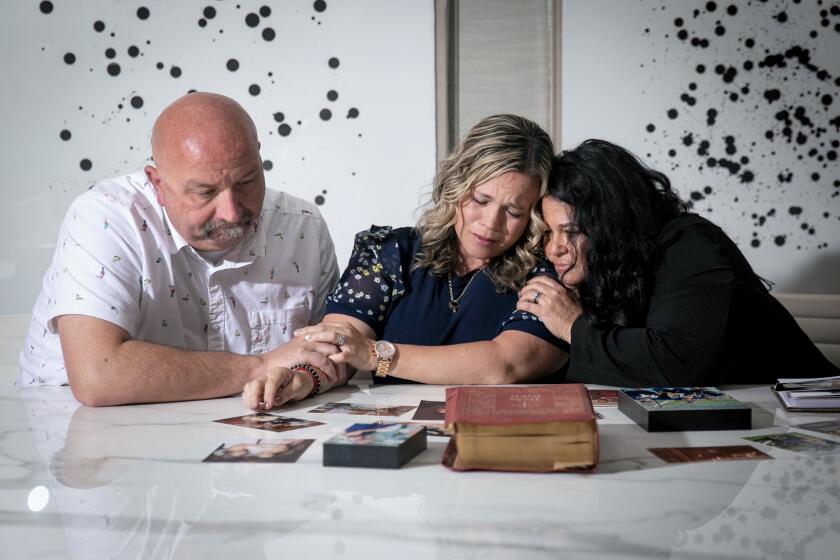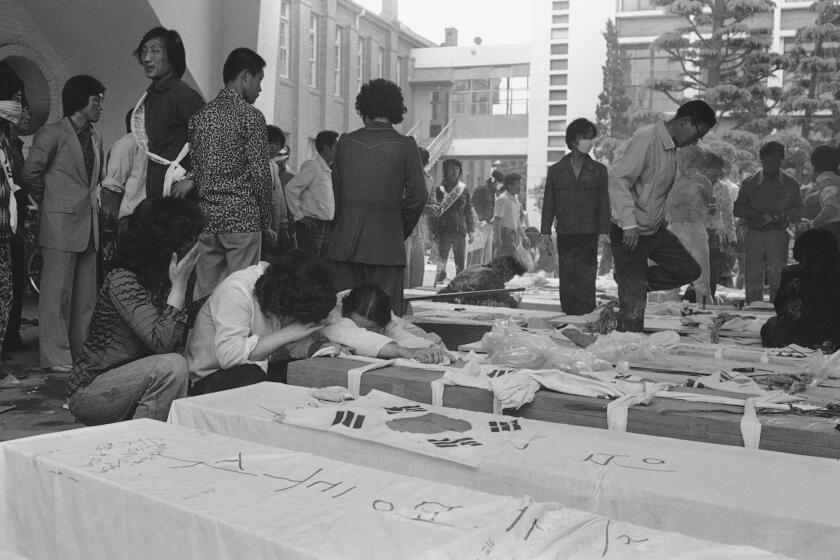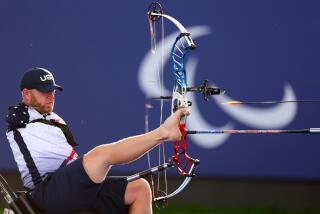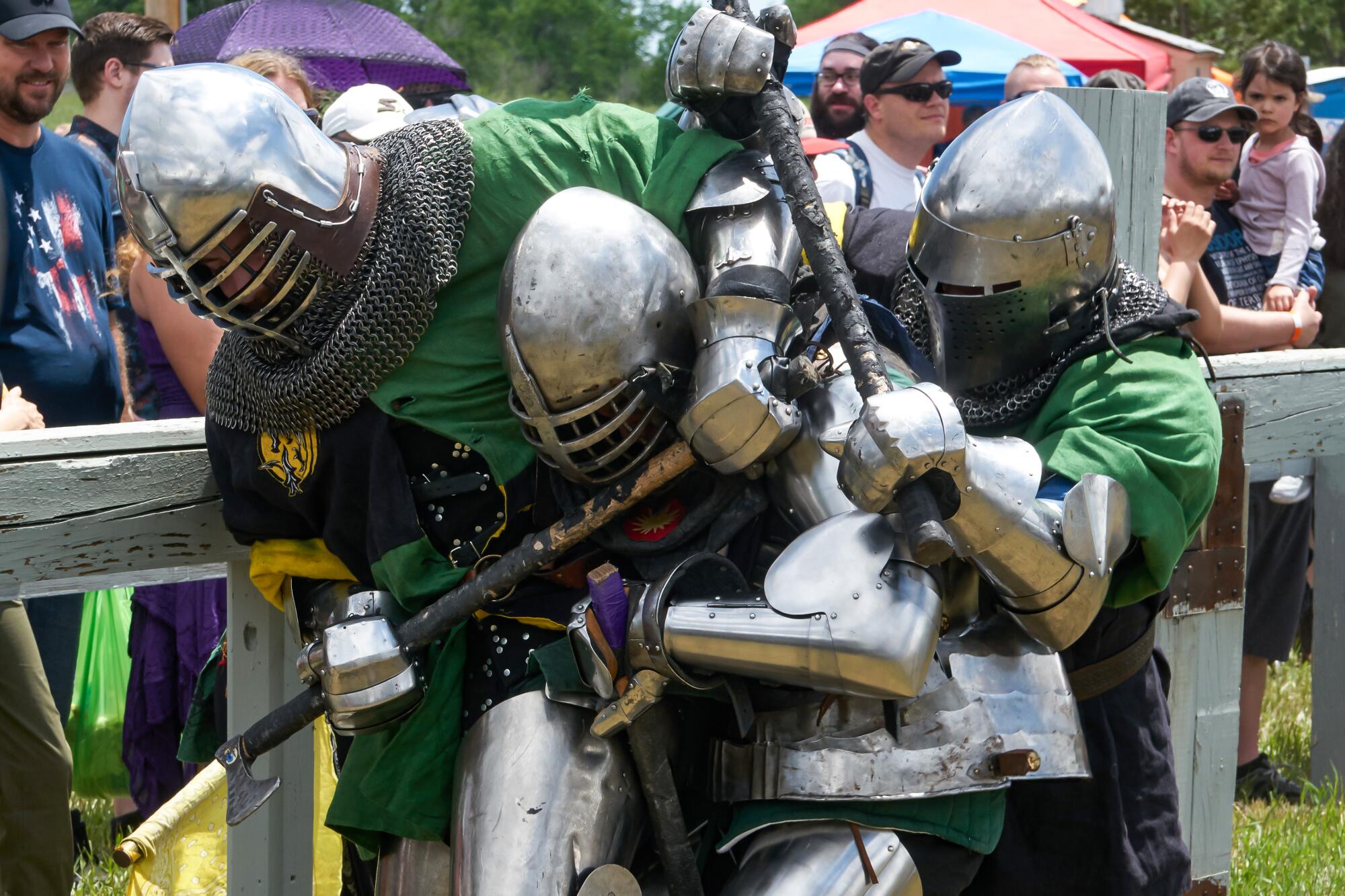
LOVELAND, Colo. — Pinned against a wooden rail, battered with axes, the knight staggered. Two attackers, clad in armor from head to toe, tried to kick his legs from under him.
There was a flash of steel, and out of nowhere, 280 pounds of man and metal smashed into the surprised assailants, collapsing them in a clanking heap.
The audience howled.
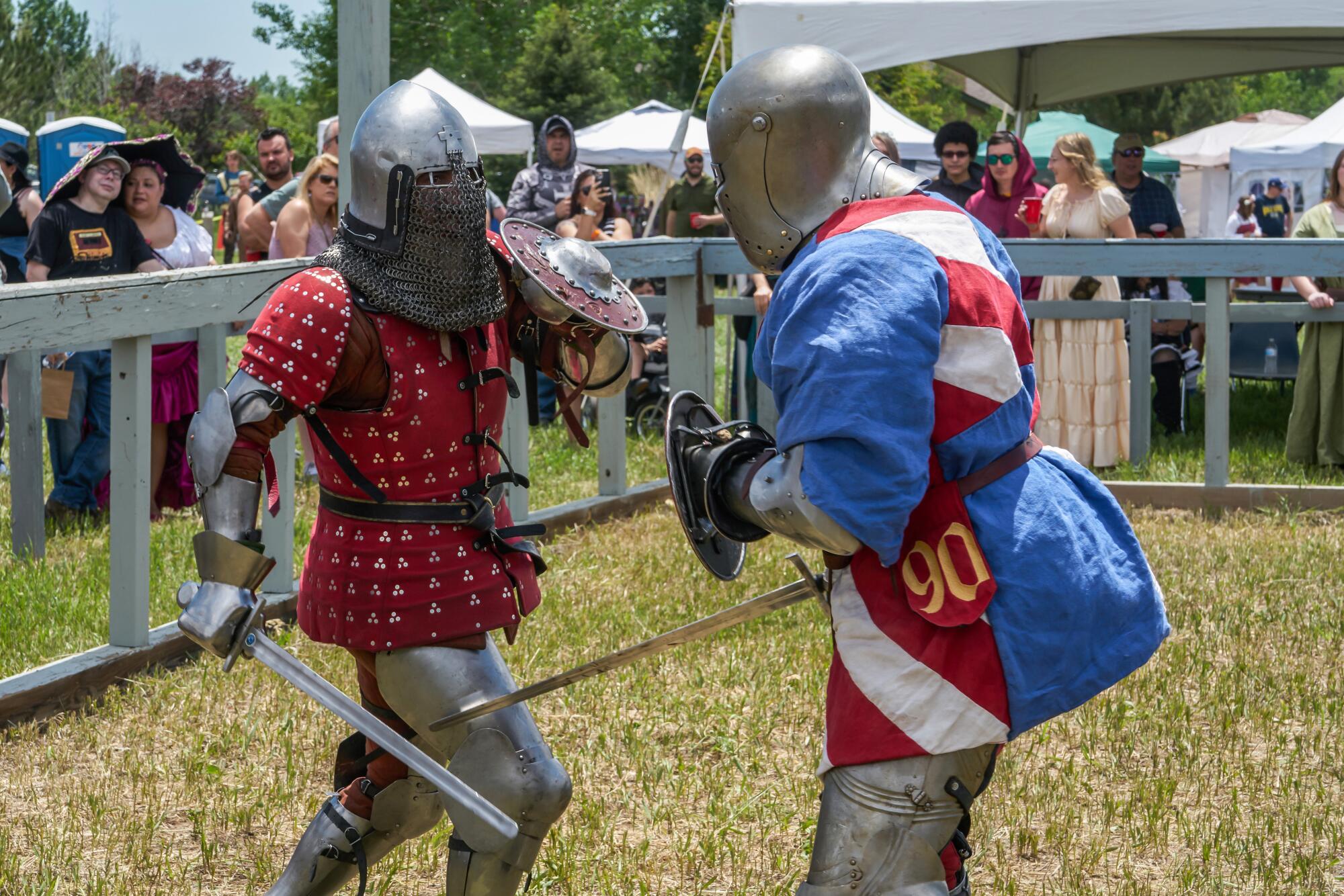
This is the world of modern medieval battle, a human demolition derby where men and women wearing up to 100 pounds of armor slash and hammer one another with blunted steel swords, axes and maces — until someone goes down, gives up or loses on points.
“Think of it as a car wreck that goes on for 90 seconds,” said David Arditi, a member of the Dallas Warlords team.
“Or a meat grinder,” fellow fighter Vince Verheyden offered.
“Yeah, that’s the word,” Arditi said. “Meat grinder.”
The next team marched into the arena for another five-on-five melee.
The marshal, or referee, yelled “fight!” and they charged, hacking with axes and swords. Shields collided with helmets. Poleaxes — long poles topped with ax heads — thundered down on shoulders with loud clangs, muffled thuds and sharp thwacks. A few fighters dropped immediately. A couple were thrown to the ground. It ended quickly.
This is the world of Buhurt, modern medieval battle where men and women wearing up to 100 pounds of armor slash and hammer each other with blunted steel swords, axes and maces until someone goes down, gives up or loses on points. Teams face off in a Buhurt competition in Loveland, Colo.
Cheering his teammates from the sidelines, then embracing them with his massive arms and praise — “I could kiss you!” — red-bearded Ian Webb waited for his match. The 6-foot-7, 300-pound member of the Colorado Wardens is a formidable opponent with an ax or sword — a WMD, weapon of medieval destruction.
And he was looking for a fight.
This is not role playing or reenactment. The armored combat sport of “buhurt” — from an old French word meaning “to wallop” — delivers adrenaline and raw violence that easily surpasses the bashing found in hockey and football. The weapons are blunt; the pain, often sharp.
Buhurt developed in the 13th century as a way for knights in feudal Europe to hone their combat skills while putting on a public spectacle.
The sport, kept alive in Russia and Ukraine, underwent a resurgence in the 1990s. The first “Battle of the Nations” was held in Ukraine in 2010, sparking global interest.
Governing bodies such as the International Medieval Combat Federation set rules for the fighters. No stabbing, no chopping the back of necks, no hitting feet, no striking behind the knees, no groin shots — similar to the 13th century but with a 21st century nod to safety like helmet padding to decrease concussions and medical care that relies more on physicians than barbers.
Most rounds — whether in group battles called melees or one-on-one duels — usually last only a minute or so. Melees can range from bouts of two versus two up to 150 versus 150, where scads of knights engage in brutal battles that, to the untrained eye, resemble attempted murder or at least assault and battery.
This is essentially a baseball bat fight while playing rugby, while wearing 80 pounds of steel, while breathing through a snorkel.
— Simon Rohrich, Buhurt icon
“Once you learn to trust your armor, a whole new world of possibilities opens up,” said Garret Skovgard of the Colorado Wardens.
If three points of contact touch the ground in a melee the fighter is out. The team with the last knight standing wins the round. Duels are won by the number of strikes on an opponent. Each strike is a point. The winner takes the best of three rounds.
Over the last few years, new teams have emerged across the U.S. with diverse memberships. There are Pacific Islander, Asian American, Arab American and Latino fighters. There are all women’s teams and teams such as the Knights of Wakanda, a group of Black fighters across the country who come together for tournaments.
Fighters say interest has been driven by the popularity of the knight battles on social media channels such as YouTube, fantasies like “Game of Thrones,” pent-up energy from the COVID-19 pandemic and a hunger for ever more full-body contact sports.
“Two common threads run through those who do this sport — you have a combat sports background or you’re a nerd into Dungeons and Dragons,” said Spence Fasching, 51, captain of Minnesota’s Twin Cities Wyverns who were fighting at the Colorado event. “I have been a nerd and a jock my whole life, so this scratches both itches for me.”
Some participants acknowledge a different motivation: “I’m just here for the violence,” said Blade Pool (his real name, he said) of the Corpus Christi Rust Knights, a 28-year-old blacksmith’s son who drove about 17 hours from Texas for the tournament.
Armor, which can cost between $1,500 and $15,000, protects against most injuries, but not all. A weapon can sometimes find a small gap. A loose chin strap can send a helmet crashing into the nose or teeth. And illegal strikes can be crippling. Fighters have suffered concussions and broken fingers, ribs, noses, legs, arms, teeth and collarbones. Kneecaps and ligaments have been torn.
During a 2016 fight, Simon Rohrich, a pioneer of the sport in the U.S., was hit in the head with an ax just as his helmet fell off. A nickel-sized piece of skull was driven a few millimeters into his brain.
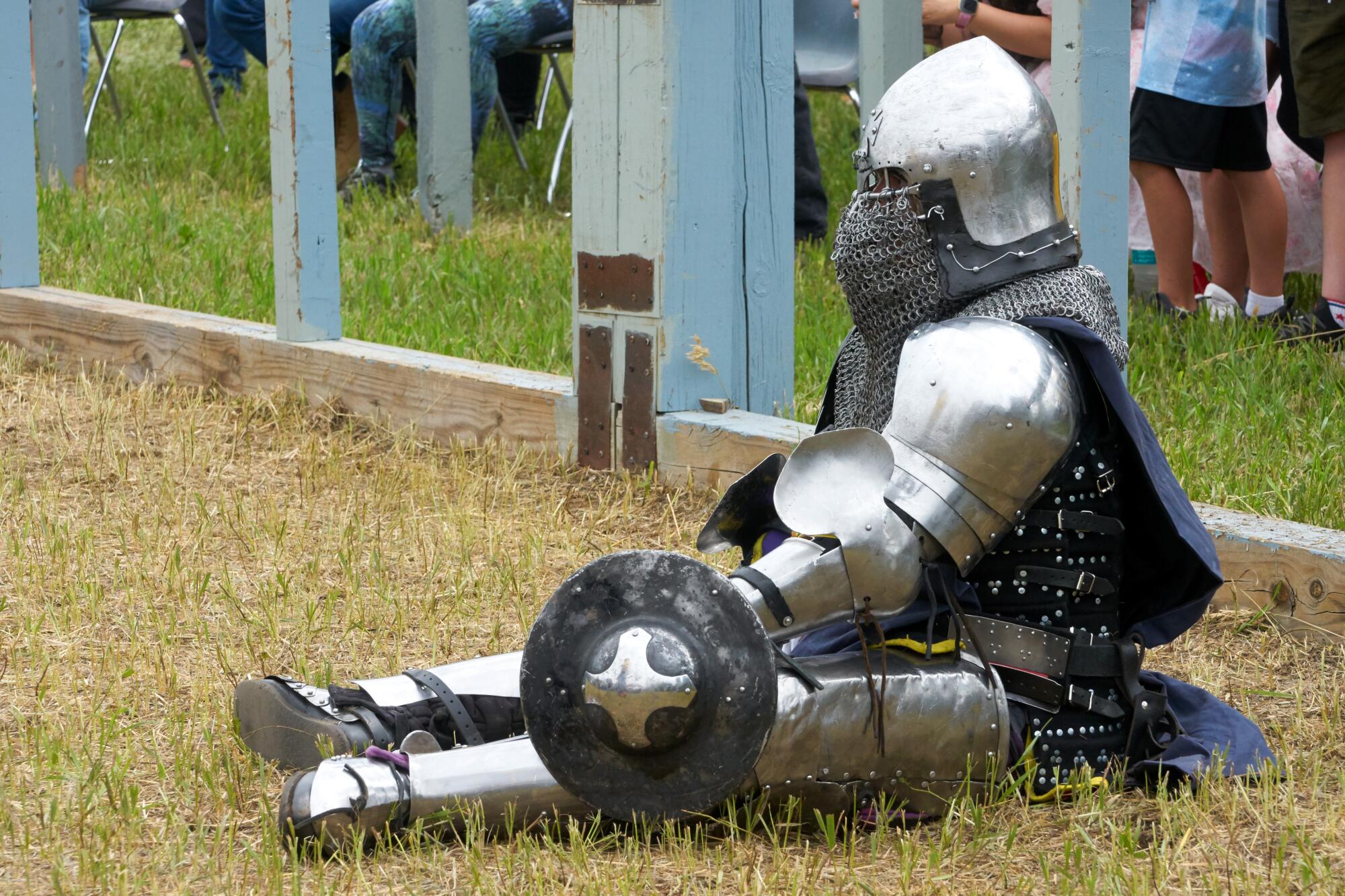
That nearly catastrophic armor failure gave birth to the “Simon strap” — Rohrich calls it the “me strap” — which better secures helmets to fighters.
Rohrich, 48, made a comeback, earning a reputation as one of the toughest, hardest-hitting fighters in the world. A fellow fighter described his strength as “almost villainly.”
Based in Tempe, Ariz., the 6-foot-1, 280-pounder began fighting in 2012 when there were nearly 30 knights in the U.S. Now he estimates there are roughly 300 active fighters. Internationally, he said, there are probably around 3,000.
Rohrich, a high-tech inventor and entrepreneur, travels the country giving seminars on armored combat he dubs “Simonars.”
“I shouldn’t say this, but you should swing hard enough at someone that it would kill them if they didn’t have armor,” he said. “This is essentially a baseball bat fight while playing rugby, while wearing 80 pounds of steel, while breathing through a snorkel.”
He calls his fighting style “nerd rage,” inspired, he says, by unresolved issues from a rough childhood in rural North Dakota. Taking the occasional blunt ax to the face helps.
“You feel alive. You feel exhilarated. It’s very therapeutic,” he said.
Whereas melees bring the crushing violence, duels are more heavy metal ballet with occasional sparks flying from helmets struck by swords. Fighters have reported a faint burning smell.
“Sword fighting,” said Aly Le, a dueler on the Colorado Wardens team, “brings out primal things I feel a lot of people suppress. We all have problems…. The point is to find a healthy outlet for them, and that’s why I am here.”
About five years ago, Le, 33, found herself drawn to weapons training and martial arts; then she discovered sword fighting. She was so taken with medieval dueling that she sold her nail salon, vehicles and house and moved in with her partner to start Synergy Sword Arts, a sword fighting school in Colorado Springs.
“It took over my life,” Le said.
She routinely practices duels with male teammates but will find a women’s team if she wants to melee.
“Dueling one on one, oh man, it’s a dance to the death,” said Le, who wasn’t fighting because medication for a recent injury had sapped her strength. “I tell people to first learn your weapon — which is you — and then learn your sword.”
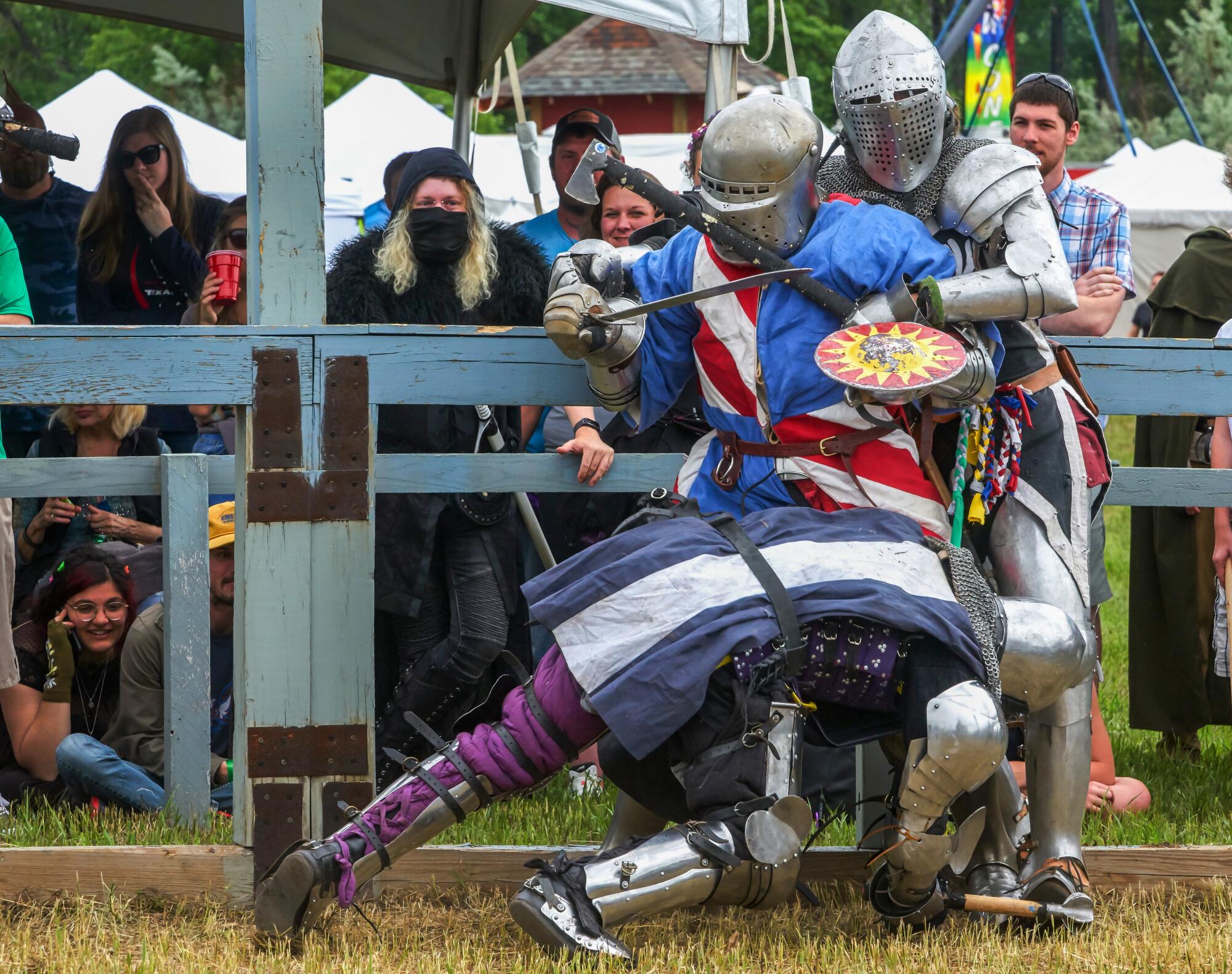
The recent three-day tournament took place at the Colorado Medieval Festival, which spread over a lush green field lined with vendors selling everything from elf ears to leather-bound books of magic spells. Beer and mead flowed freely. A smiling mermaid flapped her tail and waved from a square pool near a sign warning “Beware of Siren Song.”
The tranquility, along with the sounds of the Stubby Shillelaghs Celtic folk band, was punctured by the roar and crash of battle rising from the roughly 30-by-55 fenced arena — called a list — on the edge of the field.
Between rounds of mostly five-on-five and 10-on-10 melees, fighters staggered into a tent for quick breaks.
Sister Norma Pimentel, a nun famous for her compassion toward migrants, said that parties on both sides of the aisle turned the bus carrying migrants from Texas to L.A. into a spectacle.
“I’m bleeding, someone help me get this helmet off,” said Colorado Warden Paxton Smith, 25, who sustained a large cut above his eye.
Helmets, which can weigh 16 pounds, provide critical protection. The trade-off is that many offer a narrow window on the world, maybe an inch high. Fighters struggle to see what’s coming at them. And they speak darkly of “helmet horrors” when they hyperventilate and feel close to suffocation.
Support staff circled fighters like pit crews, swiftly removing helmets, repairing buttons and leather straps and hydrating exhausted knights.
A sweaty fighter flipped open his visor.
“Water! I need water!” he shouted.
“I need to pee,” said another.
“If you have to pee you aren’t working hard enough,” someone replied.
Another fighter removed his steel glove and examined his hand.
“I have good news and bad news,” he said. “The bad news is I can’t feel my wrist. The good news is that I can’t feel my wrist.”
Webb, the towering Colorado Warden, charged through the congested tent.
“Someone give me a weapon,” he demanded. “I need a weapon.”
He grabbed an ax lying on a table.
“We need five!” said Greg Fisher, the Wardens captain, calling for the team to get back on the field.
Since some teams sent only a handful of fighters, the squads were often a mix of knights from different groups. Sometimes it was Rust Knights and Wyverns against Wardens and Warlords and sometimes it was changed up. Fighting was all that mattered.
Webb huddled with his teammates.
“Push them all the way to their rail, then push over to the other side,” he said. “Try to cause a lot of chaos, alright?”
Two teams of five rolled out and faced each other. They wore brightly colored outer garments called surcoats over their armor. Each had different roles: Strikers hack at opponents, checkers run into them and knock them down, grapplers throw them to the ground.
Virginia cop Austin Lee Edwards spoke to Mychelle Blandin the day he killed her sister and parents, kidnapped her niece and burned down their Riverside home, Blandin told The Times in an interview.
“Fight!” the marshal commanded.
They advanced warily. Given his height and 400-pound weight in armor, Webb was a big but dangerous target. Two teammates in front tried to fend off attackers while he delivered heavy blows.
But Webb was quickly mobbed and battered from every direction.
Corpus Christi’s Blade Pool punched him in the face, then kneed him. Webb punched back. Pool swung his ax into Webb’s gut. The audience gasped. Ben Splitter of the Wardens rushed headlong into Pool, jamming him up against the fence in a mighty collision of metal on metal.
Keegan Kropf of the Wyverns, who has a boxing and wrestling background, leveled opponents with a great falchion, a beefy-edged chopping sword. He advanced on Webb, who bent under the blows.
A teammate charged Kropf but was quickly beaten to the ground. That left just Webb, facing three opponents. Melees are stopped when it’s three or more against one, so the marshal ended the fight, giving the win to the other team.
Fisher, a schoolteacher and cross-country coach, observed from the sidelines, impressed by the turnout. He could muster only five people to fight at the festival last year. This time there were nearly 30.
As South Korea confronts a dark chapter of its history, a former soldier’s quest for repentance becomes a lesson in the fragility of memory.
“Interest has increased exponentially,” he said. “We’d like to start a women’s team and maybe an armored combat school.”
Many of the fighters — engineers, electricians, auditors, software developers, supplement salesmen, military veterans and machinists — bonded during the tournament. A lot were tall and stocky, reminiscent of earlier days as high school wrestlers, football players or boxers.
One would bludgeon another with a mace, help him up and then compliment him on his technique. When a fighter accidentally delivered an illegal hit, he swiftly apologized and took a knee to indicate his mistake.
As the tournament ended, the fighters changed up the traditional melee. Rather than clock each other with axes and swords, they belted each other with frying pans, golf clubs and metal chairs — an homage to professional wrestling. It was all in good, clattering fun, showcasing the protective qualities of armor.
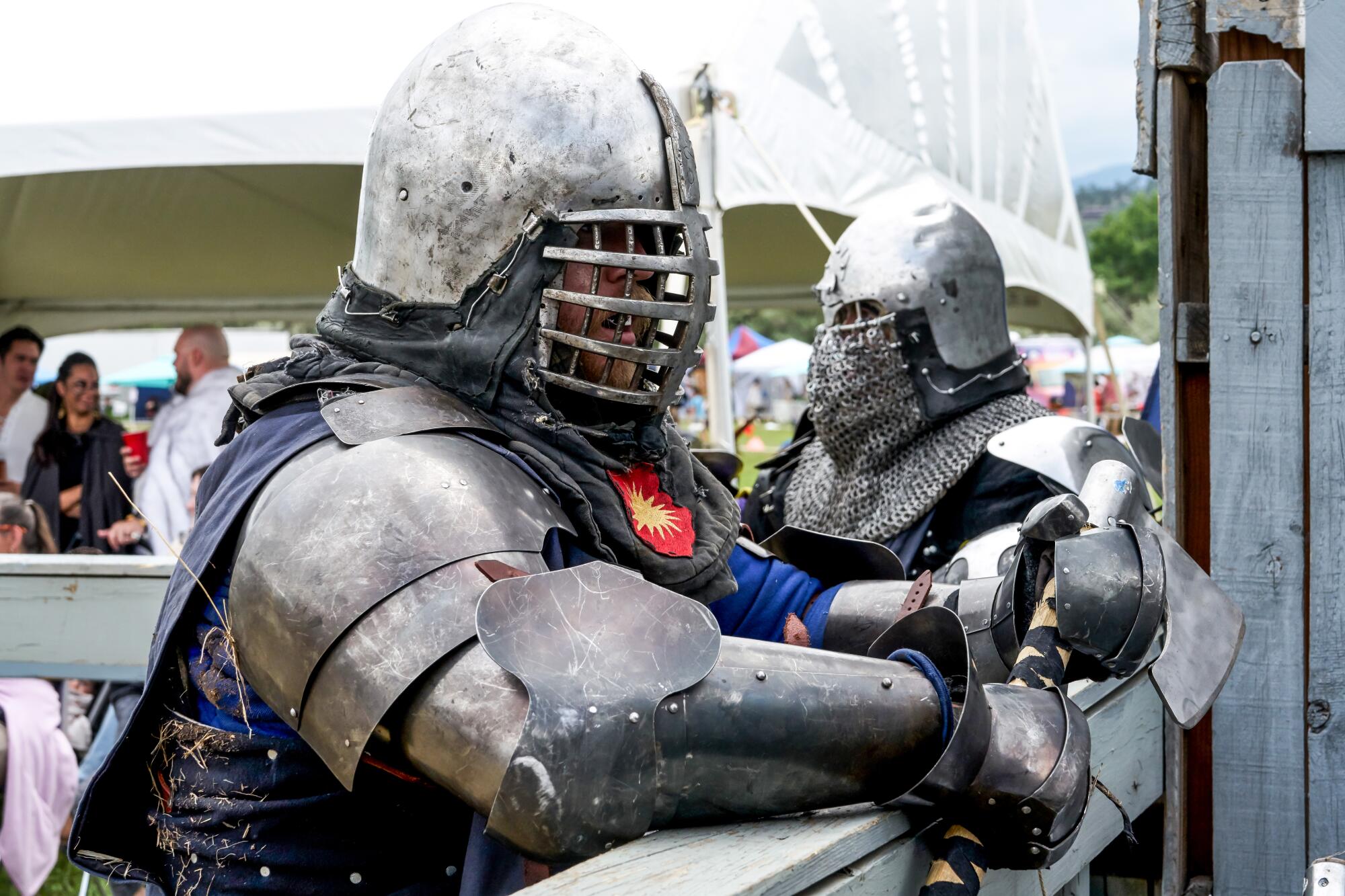
Afterward, the knights relaxed in the tent, riding a wave of combat-fueled endorphins they say can last for hours.
Webb said he tends to bottle up a week’s frustration, then blow it off in melees.
“We are all here beating the crap out of each other, and when it’s over you are all friends,” he said. “Once you get started, what really hooks you in is the community.”
“Violence has a really weird way of bringing people together,” added Pool, who walked in carrying a hefty executioner’s sword, a favorite.
Kelly is a special correspondent.
More to Read
Sign up for Essential California
The most important California stories and recommendations in your inbox every morning.
You may occasionally receive promotional content from the Los Angeles Times.


